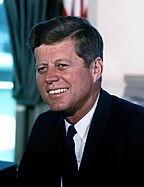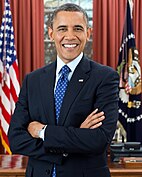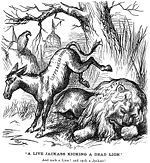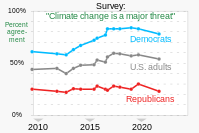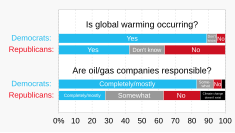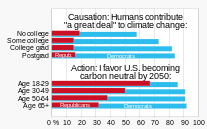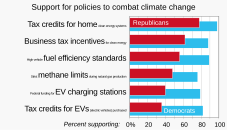
A | B | C | D | E | F | G | H | CH | I | J | K | L | M | N | O | P | Q | R | S | T | U | V | W | X | Y | Z | 0 | 1 | 2 | 3 | 4 | 5 | 6 | 7 | 8 | 9
Democratic Party | |
|---|---|
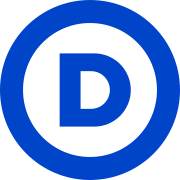 | |
| Chairperson | Jaime Harrison |
| Governing body | Democratic National Committee[1][2] |
| U.S. President | Joe Biden |
| U.S. Vice President | Kamala Harris |
| Senate Majority Leader | Chuck Schumer |
| House Minority Leader | Hakeem Jeffries |
| Founders | |
| Founded | January 8, 1828[3] Baltimore, Maryland, U.S. |
| Preceded by | Democratic-Republican Party |
| Headquarters | 430 South Capitol St. SE, Washington, D.C., U.S. |
| Student wing | |
| Youth wing | Young Democrats of America |
| Women's wing | National Federation of Democratic Women |
| Overseas wing | Democrats Abroad |
| Membership (2023) | |
| Ideology | |
| Colors | Blue |
| Senate | 47 / 100[b] |
| House of Representatives | 213 / 435 |
| State Governors | 23 / 50 |
| State upper chambers | 857 / 1,973 |
| State lower chambers | 2,425 / 5,413 |
| Territorial Governors | 4 / 5 |
| Seats in Territorial upper chambers | 31 / 97 |
| Seats in Territorial lower chambers | 9 / 91 |
| Election symbol | |
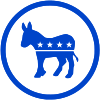 | |
| Website | |
| democrats | |
The Democratic Party is one of the two major contemporary political parties in the United States. Since the 1850s, its main political rival has been the Republican Party.
The Democratic Party was founded in 1828. Martin Van Buren of New York played the central role in building the coalition of state organizations that formed a new party as a vehicle to elect Andrew Jackson of Tennessee. The Democratic Party is often called the world's oldest active political party.[9][10][11] The party supported expansive presidential power,[12] the interests of slave states,[13] agrarianism,[14] and geographical expansionism,[14] while opposing a national bank and high tariffs.[14] It split in 1860 over slavery and won the presidency only twice[c] in the fifty years between 1860 and 1910, although it won the popular vote a total of four times in that period. In the late 19th century, it continued to oppose high tariffs and had fierce internal debates on the gold standard. In the early 20th century, it supported progressive reforms and opposed imperialism, with Woodrow Wilson winning the White House in 1912 and 1916.
Since Franklin D. Roosevelt was elected president in 1932, the Democratic Party has promoted a social liberal platform that includes support for Social Security and unemployment insurance.[5][15][16] The New Deal attracted strong support for the party from recent European immigrants but diminished the party's pro-business wing.[17][18][19] From late in Roosevelt's administration through the 1950s, a minority in the party's Southern wing joined with conservative Republicans to slow and stop progressive domestic reforms.[20] Following the Great Society era of progressive legislation under Lyndon B. Johnson, which was often able to overcome the conservative coalition in the 1960s, the core bases of the parties shifted, with the Southern states becoming more reliably Republican and the Northeastern states becoming more reliably Democratic.[21][22] The party's labor union element has become smaller since the 1970s,[23][24] and as the American electorate shifted in a more conservative direction following Ronald Reagan's presidency, the election of Bill Clinton marked a move for the party toward the Third Way, moving the party's economic stance towards market-based economic policy.[25][26][27] Barack Obama oversaw the party's passage of the Affordable Care Act in 2010. During Joe Biden's presidency, the party has adopted an increasingly progressive economic agenda.[28]
In the 21st century, the party is strongest among urban voters, union workers, college graduates,[29][30] African Americans,[31][32][33] sexual minorities,[34][35][36] and the unmarried. On social issues, it advocates for abortion rights,[37] the legalization of marijuana,[38] and LGBT rights.[39] On economic issues, the party favors significant increases in healthcare coverage, universal child care, paid sick leave, and supporting unions.[40][41][42][43] In foreign policy, the party supports liberal internationalism, as well as tough stances against China and Russia.[44][45][46]
History

Democratic Party officials often trace its origins to the Democratic-Republican Party, founded by Thomas Jefferson, James Madison and other influential opponents of the conservative Federalists in 1792.[47][48] That party died out before the modern Democratic Party was organized;[49] the Jeffersonian party also inspired the Whigs and modern Republicans.[50] Historians argue that the modern Democratic Party was first organized in the late 1820s with the election of Andrew Jackson,[11] making it the world's oldest active political party.[10] It was predominately built by Martin Van Buren, who assembled a wide cadre of politicians in every state behind war hero Andrew Jackson of Tennessee.[9][11]
Since the nomination of William Jennings Bryan in 1896, the party has generally positioned itself to the left of the Republican Party on economic issues. Democrats have been more liberal on civil rights since 1948, although conservative factions within the Democratic Party that opposed them persisted in the South until the 1960s. On foreign policy, both parties have changed positions several times.[51]
Background
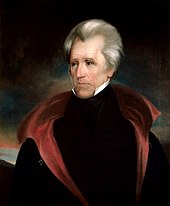
The Democratic Party evolved from the Jeffersonian Republican or Democratic-Republican Party organized by Jefferson and Madison in opposition to the Federalist Party.[52] The Democratic-Republican Party favored republicanism; a weak federal government; states' rights; agrarian interests (especially Southern planters); and strict adherence to the Constitution. The party opposed a national bank and Great Britain.[53] After the War of 1812, the Federalists virtually disappeared and the only national political party left was the Democratic-Republicans, which was prone to splinter along regional lines.[54] The era of one-party rule in the United States, known as the Era of Good Feelings, lasted from 1816 until 1828, when Andrew Jackson became president. Jackson and Martin Van Buren worked with allies in each state to form a new Democratic Party on a national basis. In the 1830s, the Whig Party coalesced into the main rival to the Democrats.
Before 1860, the Democratic Party supported expansive presidential power,[12] the interests of slave states,[13] agrarianism,[14] and expansionism,[14] while opposing a national bank and high tariffs.[14]
19th century

The Democratic-Republican Party split over the choice of a successor to President James Monroe.[55] The faction that supported many of the old Jeffersonian principles, led by Andrew Jackson and Martin Van Buren, became the modern Democratic Party.[56] Historian Mary Beth Norton explains the transformation in 1828:
Jacksonians believed the people's will had finally prevailed. Through a lavishly financed coalition of state parties, political leaders, and newspaper editors, a popular movement had elected the president. The Democrats became the nation's first well-organized national party ... and tight party organization became the hallmark of nineteenth-century American politics.[57]

Behind the platforms issued by state and national parties stood a widely shared political outlook that characterized the Democrats:
The Democrats represented a wide range of views but shared a fundamental commitment to the Jeffersonian concept of an agrarian society. They viewed the central government as the enemy of individual liberty. The 1824 "corrupt bargain" had strengthened their suspicion of Washington politics. ... Jacksonians feared the concentration of economic and political power. They believed that government intervention in the economy benefited special-interest groups and created corporate monopolies that favored the rich. They sought to restore the independence of the individual—the artisan and the ordinary farmer—by ending federal support of banks and corporations and restricting the use of paper currency, which they distrusted. Their definition of the proper role of government tended to be negative, and Jackson's political power was largely expressed in negative acts. He exercised the veto more than all previous presidents combined. ... Nor did Jackson share reformers' humanitarian concerns. He had no sympathy for American Indians, initiating the removal of the Cherokees along the Trail of Tears.[58]
Opposing factions led by Henry Clay helped form the Whig Party. The Democratic Party had a small yet decisive advantage over the Whigs until the 1850s when the Whigs fell apart over the issue of slavery. In 1854, angry with the Kansas–Nebraska Act, anti-slavery Democrats left the party and joined Northern Whigs to form the Republican Party.[59][60]
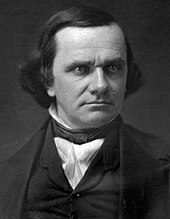
The Democrats split over slavery, with Northern and Southern tickets in the election of 1860, in which the Republican Party gained ascendancy.[61] The radical pro-slavery Fire-Eaters led walkouts at the two conventions when the delegates would not adopt a resolution supporting the extension of slavery into territories even if the voters of those territories did not want it. These Southern Democrats nominated the pro-slavery incumbent vice president, John C. Breckinridge of Kentucky, for president and General Joseph Lane, of Oregon, for vice president. The Northern Democrats nominated Senator Stephen A. Douglas of Illinois for president and former Georgia Governor Herschel V. Johnson for vice president. This fracturing of the Democrats led to a Republican victory and Abraham Lincoln was elected the 16th president of the United States.[62]
As the American Civil War broke out, Northern Democrats were divided into War Democrats and Peace Democrats. The Confederate States of America deliberately avoided organized political parties. Most War Democrats rallied to Republican President Abraham Lincoln and the Republicans' National Union Party in the election of 1864, which featured Andrew Johnson on the Union ticket to attract fellow Democrats. Johnson replaced Lincoln in 1865, but he stayed independent of both parties.[63]
The Democrats benefited from white Southerners' resentment of Reconstruction after the war and consequent hostility to the Republican Party. After Redeemers ended Reconstruction in the 1870s and following the often extremely violent disenfranchisement of African Americans led by such white supremacist Democratic politicians as Benjamin Tillman of South Carolina in the 1880s and 1890s, the South, voting Democratic, became known as the "Solid South". Although Republicans won all but two presidential elections, the Democrats remained competitive. The party was dominated by pro-business Bourbon Democrats led by Samuel J. Tilden and Grover Cleveland, who represented mercantile, banking, and railroad interests; opposed imperialism and overseas expansion; fought for the gold standard; opposed bimetallism; and crusaded against corruption, high taxes and tariffs. Cleveland was elected to non-consecutive presidential terms in 1884 and 1892.[64]
20th century
Early 20th century

Agrarian Democrats demanding free silver, drawing on Populist ideas, overthrew the Bourbon Democrats in 1896 and nominated William Jennings Bryan for the presidency (a nomination repeated by Democrats in 1900 and 1908). Bryan waged a vigorous campaign attacking Eastern moneyed interests, but he lost to Republican William McKinley.[65]
The Democrats took control of the House in 1910, and Woodrow Wilson won election as president in 1912 (when the Republicans split) and 1916. Wilson effectively led Congress to put to rest the issues of tariffs, money, and antitrust, which had dominated politics for 40 years, with new progressive laws. He failed to secure Senate passage of the Versailles Treaty (ending the war with Germany and joining the League of Nations).[66] The weak party was deeply divided by issues such as the KKK and prohibition in the 1920s. However, it did organize new ethnic voters in Northern cities.[67]
After World War I ended and continuing through the Great Depression, the Democratic and Republican Parties both largely believed in American exceptionalism over European monarchies and state socialism that existed elsewhere in the world.[68]
1930s–1960s and the rise of the New Deal coalition

The Great Depression in 1929 that began under Republican President Herbert Hoover and the Republican Congress set the stage for a more liberal government as the Democrats controlled the House of Representatives nearly uninterrupted from 1930 until 1994, the Senate for 44 of 48 years from 1930, and won most presidential elections until 1968. Franklin D. Roosevelt, elected to the presidency in 1932, came forth with federal government programs called the New Deal. New Deal liberalism meant the regulation of business (especially finance and banking) and the promotion of labor unions as well as federal spending to aid the unemployed, help distressed farmers and undertake large-scale public works projects. It marked the start of the American welfare state.[69] The opponents, who stressed opposition to unions, support for business and low taxes, started calling themselves "conservatives".[70]
Until the 1980s, the Democratic Party was a coalition of two parties divided by the Mason–Dixon line: liberal Democrats in the North and culturally conservative voters in the South, who though benefitting from many of the New Deal public works projects, opposed increasing civil rights initiatives advocated by northeastern liberals. The polarization grew stronger after Roosevelt died. Southern Democrats formed a key part of the bipartisan conservative coalition in an alliance with most of the Midwestern Republicans. The economically activist philosophy of Franklin D. Roosevelt, which has strongly influenced American liberalism, shaped much of the party's economic agenda after 1932.[71] From the 1930s to the mid-1960s, the liberal New Deal coalition usually controlled the presidency while the conservative coalition usually controlled Congress.[72]
1960s–1980s and the collapse of the New Deal coalition
Issues facing parties and the United States after World War II included the Cold War and the civil rights movement. Republicans attracted conservatives and, after the 1960s, white Southerners from the Democratic coalition with their use of the Southern strategy and resistance to New Deal and Great Society liberalism. Until the 1950s, African Americans had traditionally supported the Republican Party because of its anti-slavery civil rights policies. Following the passage of the Civil Rights Act of 1964 and Voting Rights Act of 1965, the Southern states became more reliably Republican in presidential politics, while Northeastern states became more reliably Democratic.[73][74][75][76] Studies show that Southern whites, which were a core constituency in the Democratic Party, shifted to the Republican Party due to racial backlash and social conservatism.[77][78][79]
The election of President John F. Kennedy from Massachusetts in 1960 partially reflected this shift. In the campaign, Kennedy attracted a new generation of younger voters. In his agenda dubbed the New Frontier, Kennedy introduced a host of social programs and public works projects, along with enhanced support of the space program, proposing a crewed spacecraft trip to the moon by the end of the decade. He pushed for civil rights initiatives and proposed the Civil Rights Act of 1964, but with his assassination in November 1963, he was not able to see its passage.[80]
Kennedy's successor Lyndon B. Johnson was able to persuade the largely conservative Congress to pass the Civil Rights Act of 1964 and with a more progressive Congress in 1965 passed much of the Great Society, including Medicare, which consisted of an array of social programs designed to help the poor, sick, and elderly. Kennedy and Johnson's advocacy of civil rights further solidified black support for the Democrats but had the effect of alienating Southern whites who would eventually gravitate toward the Republican Party, particularly after the election of Ronald Reagan to the presidency in 1980. Many conservative Southern Democrats defected to the Republican Party, beginning with the passage of the Civil Rights Act of 1964 and the general leftward shift of the party.[81][82][35][83]
The United States' involvement in the Vietnam War in the 1960s was another divisive issue that further fractured the fault lines of the Democrats' coalition. After the Gulf of Tonkin Resolution in 1964, President Johnson committed a large contingency of combat troops to Vietnam, but the escalation failed to drive the Viet Cong from South Vietnam, resulting in an increasing quagmire, which by 1968 had become the subject of widespread anti-war protests in the United States and elsewhere. With increasing casualties and nightly news reports bringing home troubling images from Vietnam, the costly military engagement became increasingly unpopular, alienating many of the kinds of young voters that the Democrats had attracted in the early 1960s. The protests that year along with assassinations of Martin Luther King Jr. and Democratic presidential candidate Senator Robert F. Kennedy (younger brother of John F. Kennedy) climaxed in turbulence at the hotly-contested Democratic National Convention that summer in Chicago (which amongst the ensuing turmoil inside and outside of the convention hall nominated Vice President Hubert Humphrey) in a series of events that proved to mark a significant turning point in the decline of the Democratic Party's broad coalition.[84]
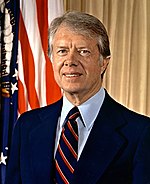
Republican presidential nominee Richard Nixon was able to capitalize on the confusion of the Democrats that year, and won the 1968 election to become the 37th president. He won re-election in a landslide in 1972 against Democratic nominee George McGovern, who like Robert F. Kennedy, reached out to the younger anti-war and counterculture voters, but unlike Kennedy, was not able to appeal to the party's more traditional white working-class constituencies. During Nixon's second term, his presidency was rocked by the Watergate scandal, which forced him to resign in 1974. He was succeeded by vice president Gerald Ford, who served a brief tenure.
Watergate offered the Democrats an opportunity to recoup, and their nominee Jimmy Carter won the 1976 presidential election. With the initial support of evangelical Christian voters in the South, Carter was temporarily able to reunite the disparate factions within the party, but inflation and the Iran Hostage Crisis of 1979–1980 took their toll, resulting in a landslide victory for Republican presidential nominee Ronald Reagan in 1980, which shifted the political landscape in favor of the Republicans for years to come. The influx of conservative Democrats into the Republican Party is often cited as a reason for the Republican Party's shift further to the right during the late 20th century as well as the shift of its base from the Northeast and Midwest to the South.[85][86]
1990s and Third Way centrism

With the ascendancy of the Republicans under Ronald Reagan, the Democrats searched for ways to respond yet were unable to succeed by running traditional candidates, such as former vice president and Democratic presidential nominee Walter Mondale and Massachusetts Governor Michael Dukakis, who lost to Reagan and George H.W. Bush in the 1984 and 1988 presidential elections, respectively. Many Democrats attached their hopes to the future star of Gary Hart, who had challenged Mondale in the 1984 primaries running on a theme of "New Ideas"; and in the subsequent 1988 primaries became the de facto front-runner and virtual "shoo-in" for the Democratic presidential nomination before a sex scandal ended his campaign. The party nevertheless began to seek out a younger generation of leaders, who like Hart had been inspired by the pragmatic idealism of John F. Kennedy.[87]
Arkansas governor Bill Clinton was one such figure, who was elected president in 1992 as the Democratic nominee. The Democratic Leadership Council was a campaign organization connected to Clinton that advocated a realignment and triangulation under the re-branded "New Democrat" label.[88][25][26] The party adopted a synthesis of neoliberal economic policies with cultural liberalism, with the voter base after Reagan having shifted considerably to the right.[88] In an effort to appeal both to liberals and to fiscal conservatives, Democrats began to advocate for a balanced budget and market economy tempered by government intervention (mixed economy), along with a continued emphasis on social justice and affirmative action. The economic policy adopted by the Democratic Party, including the former Clinton administration, has been referred to as "Third Way".
The Democrats lost control of Congress in the election of 1994 to the Republican Party. Re-elected in 1996, Clinton was the first Democratic president since Franklin D. Roosevelt to be elected to two terms.[89] Al Gore won the popular vote, but after a controversial election dispute over a Florida recount settled by the U.S. Supreme Court (which ruled 5–4 in favor of Bush) he lost the 2000 United States Presidential Election to Republican opponent George W. Bush in the Electoral College.[90]
21st century
2000s
In the wake of the 2001 terrorist attacks on the World Trade Center and the Pentagon as well as the growing concern over global warming, some of the party's key issues in the early 21st century have included combating terrorism while preserving human rights, expanding access to health care, labor rights, and environmental protection. Democrats regained majority control of both the House and the Senate in the 2006 elections. Barack Obama won the Democratic Party's nomination and was elected as the first African American president in 2008. Under the Obama presidency, the party moved forward reforms including an economic stimulus package, the Dodd–Frank financial reform act, and the Affordable Care Act.[91]
2010s
In the 2010 midterm elections, the Democratic Party lost control of the House and lost its majority in state legislatures and state governorships. In the 2012 elections, President Obama was re-elected, but the party remained in the minority in the House of Representatives and lost control of the Senate in the 2014 midterm elections. After the 2016 election of Donald Trump, who lost the popular vote, the Democratic Party transitioned into the role of an opposition party and held neither the presidency nor Congress for two years. However, the Democratic Party won back a majority in the House in the 2018 midterm elections under the leadership of Nancy Pelosi.
Democrats were extremely critical of President Trump, particularly his policies on immigration, healthcare, and abortion, as well as his response to the COVID-19 pandemic.[92][93][94] In December 2019, Democrats in the House of Representatives impeached Trump for the first time, although Trump was acquitted in the Republican-controlled Senate.[95]
2020s
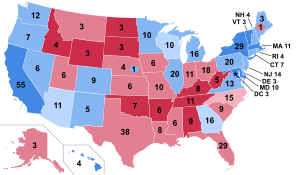
In November 2020, Democrat Joe Biden won the 2020 presidential election.[96] He began his term with extremely narrow Democratic majorities in the U.S. House and Senate.[97][98] The Inflation Reduction Act of 2022 was negotiated by Biden, Majority Leader Chuck Schumer, Joe Manchin, Kyrsten Sinema and other Democrats and is the largest allocation of funds for addressing climate change in the history of the United States to date.[99][100] Biden also signed a major infrastructure bill with bipartisan support, the first federal gun safety legislation in 28 years, and appointed the most federal judges during the first two years of any presidency since John F. Kennedy.[101]
The 2022 Russian invasion of Ukraine was politically and economically opposed by the Biden Administration, who promptly began an increased arming of Ukraine, with full support from Congressional Democrats and an overwhelming majority of Republicans.[102][103]
In 2022, Biden appointed Ketanji Brown Jackson, the first Black woman on the Supreme Court. However, she was replacing liberal justice Stephen Breyer, so she did not alter the court's 6–3 split between conservatives (the majority) and liberals.[104][105][106][107] After Dobbs v. Jackson (decided June 24, 2022), which led to abortion bans in much of the country, the Democratic Party rallied behind abortion rights.[37]
In the 2022 midterm elections, Democrats dramatically outperformed historical trends, and a widely anticipated red wave did not materialize.[108][109] Democrats only narrowly lost their majority in the U.S. House, and gained a seat in the U.S. Senate,[110][111][112] along with several gains at the state level, including acquiring "trifectas" (control of both legislative houses and governor's seat) in several states.[113][114][115][116][117]
As of 2024, Democrats hold the presidency and a majority in the U.S. Senate, as well as 23 state governorships, 19 state legislatures, 17 state government trifectas, and the mayorships in the majority of the country's major cities.[118] Three of the nine current U.S. Supreme Court justices were appointed by Democratic presidents. By registered members, the Democratic Party is the largest party in the U.S. and the fourth largest in the world. Including the incumbent, Biden, 16 Democrats have served as president of the United States.[5]
Name and symbols
The Democratic-Republican Party splintered in 1824 into the short-lived National Republican Party and the Jacksonian movement which in 1828 became the Democratic Party. Under the Jacksonian era, the term "The Democracy" was in use by the party, but the name "Democratic Party" was eventually settled upon[119] and became the official name in 1844.[120] Members of the party are called "Democrats" or "Dems".
The most common mascot symbol for the party has been the donkey, or jackass.[121] Andrew Jackson's enemies twisted his name to "jackass" as a term of ridicule regarding a stupid and stubborn animal. However, the Democrats liked the common-man implications and picked it up too, therefore the image persisted and evolved.[122] Its most lasting impression came from the cartoons of Thomas Nast from 1870 in Harper's Weekly. Cartoonists followed Nast and used the donkey to represent the Democrats and the elephant to represent the Republicans.
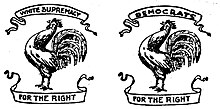
In the early 20th century, the traditional symbol of the Democratic Party in Indiana, Kentucky, Oklahoma and Ohio was the rooster, as opposed to the Republican eagle.[125] The rooster was also adopted as an official symbol of the national Democratic Party.[126] In 1904, the Alabama Democratic Party chose, as the logo to put on its ballots, a rooster with the motto "White supremacy – For the right."[127] The words "White supremacy" were replaced with "Democrats" in 1966.[128][123] In 1996, the Alabama Democratic Party dropped the rooster, citing racist and white supremacist connotations linked with the symbol.[124] The rooster symbol still appears on Oklahoma, Kentucky, Indiana, and West Virginia ballots.[125] In New York, the Democratic ballot symbol is a five-pointed star.[129]
Although both major political parties (and many minor ones) use the traditional American colors of red, white, and blue in their marketing and representations, since election night 2000 blue has become the identifying color for the Democratic Party while red has become the identifying color for the Republican Party. That night, for the first time all major broadcast television networks used the same color scheme for the electoral map: blue states for Al Gore (Democratic nominee) and red states for George W. Bush (Republican nominee). Since then, the color blue has been widely used by the media to represent the party. This is contrary to common practice outside of the United States where blue is the traditional color of the right and red the color of the left.[130]
Jefferson-Jackson Day is the annual fundraising event (dinner) held by Democratic Party organizations across the United States.[131] It is named after Presidents Thomas Jefferson and Andrew Jackson, whom the party regards as its distinguished early leaders.
The song "Happy Days Are Here Again" is the unofficial song of the Democratic Party. It was used prominently when Franklin D. Roosevelt was nominated for president at the 1932 Democratic National Convention and remains a sentimental favorite for Democrats. For example, Paul Shaffer played the theme on the Late Show with David Letterman after the Democrats won Congress in 2006. "Don't Stop" by Fleetwood Mac was adopted by Bill Clinton's presidential campaign in 1992 and has endured as a popular Democratic song. The emotionally similar song "Beautiful Day" by the band U2 has also become a favorite theme song for Democratic candidates. John Kerry used the song during his 2004 presidential campaign and several Democratic Congressional candidates used it as a celebratory tune in 2006.[132][133]
As a traditional anthem for its presidential nominating convention, Aaron Copland's "Fanfare for the Common Man" is traditionally performed at the beginning of the Democratic National Convention.
Structure
National committee
The Democratic National Committee (DNC) is responsible for promoting Democratic campaign activities. While the DNC is responsible for overseeing the process of writing the Democratic Platform, the DNC is more focused on campaign and organizational strategy than public policy. In presidential elections, it supervises the Democratic National Convention. The national convention is subject to the charter of the party and the ultimate authority within the Democratic Party when it is in session, with the DNC running the party's organization at other times. As of 2021, the Party is chaired by Jaime Harrison.[134]
State parties
Each state also has a state committee, made up of elected committee members as well as ex officio committee members (usually elected officials and representatives of major constituencies), which in turn elects a chair. County, town, city, and ward committees generally are composed of individuals elected at the local level. State and local committees often coordinate campaign activities within their jurisdiction, oversee local conventions, and in some cases primaries or caucuses, and may have a role in nominating candidates for elected office under state law. Rarely do they have much funding, but in 2005 DNC Chairman Dean began a program (called the "50 State Strategy") of using DNC national funds to assist all state parties and pay for full-time professional staffers.[135]
Major party committees and groups
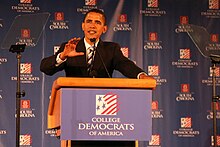
The Democratic Congressional Campaign Committee (DCCC) assists party candidates in House races and is chaired by Representative Suzan DelBene of Washington. Similarly, the Democratic Senatorial Campaign Committee (DSCC), chaired by Senator Gary Peters of Michigan, raises funds for Senate races. The Democratic Legislative Campaign Committee (DLCC), chaired by Majority Leader of the New York State Senate Andrea Stewart-Cousins, is a smaller organization that focuses on state legislative races. The Democratic Governors Association (DGA) is an organization supporting the candidacies of Democratic gubernatorial nominees and incumbents. Likewise, the mayors of the largest cities and urban centers convene as the National Conference of Democratic Mayors.[136]
The DNC sponsors the College Democrats of America (CDA), a student-outreach organization with the goal of training and engaging a new generation of Democratic activists. Democrats Abroad is the organization for Americans living outside the United States. They work to advance the party's goals and encourage Americans living abroad to support the Democrats. The Young Democrats of America (YDA) and the High School Democrats of America (HSDA) are young adult and youth-led organizations respectively that attempt to draw in and mobilize young people for Democratic candidates but operates outside of the DNC.
Political positions
The party's platform blends civil liberty and social equality with support for a mixed capitalist economy.[137] On social issues, it advocates for the continued legality of abortion,[37] the legalization of marijuana,[38] and LGBT rights.[39]
On economic issues, it favors universal healthcare coverage, industrial policy, universal child care, paid sick leave, corporate governance reform, and supporting unions.[40][41][42][43]
- Economic policy
- Expand Social Security and safety-net programs.[138]
- Increase the capital gains tax rate to 39.6% for taxpayers with annual income above $1 million.[139]
- Cut taxes for the working and middle classes as well as small businesses.[140]
- Change tax rules to discourage shipping jobs overseas.[140]
- Increase federal and state minimum wages.[141]
- Modernize and expand access to public education and provide universal preschool education.[142]
- Support the goal of universal health care through a public health insurance option or expanding Medicare/Medicaid.[143]
- Increase investments in infrastructure development[144] as well as scientific and technological research.[145]
- Offer tax credits to make clean energy more accessible for consumers and increase domestic production of clean energy.[146]
- Uphold labor protections and the right to unionize.[147][148]
- Reform the student loan system and allow for refinancing student loans.[149]
- Make college more affordable.[141][150]
- Mandate equal pay for equal work regardless of gender, race, or ethnicity.[151]
- Social policy
- Decriminalize or legalize marijuana.[141]
- Uphold network neutrality.[152]
- Implement campaign finance reform.[153]
- Uphold voting rights and easy access to voting.[154][155]
- Support same-sex marriage and ban conversion therapy.[141]
- Allow legal access to abortions and women's reproductive health care.[144]
- Reform the immigration system and allow for a pathway to citizenship.[144]
- Expand background checks and reduce access to assault weapons to address gun violence.[144]
- Improve privacy laws and curtail government surveillance.[144]
- Oppose torture.[156][157]
- Abolish capital punishment.[158]
- Recognize and defend Internet freedom worldwide.[140]
Economic issues
Equal economic opportunity, a social safety net, and strong labor unions have historically been at the heart of Democratic economic policy.[137] The Democratic Party's economic policy positions, as measured by votes in Congress, tend to align with those of middle class.[159][160][161][162][163] Democrats support a progressive tax system, higher minimum wages, Social Security, universal health care, public education, and subsidized housing.[137] They also support infrastructure development and clean energy investments to achieve economic development and job creation.[164] Since the 1990s, the party has at times supported centrist economic reforms that cut the size of government and reduced market regulations.[165] The party has generally rejected both laissez-faire economics and market socialism, instead favoring Keynesian economics within a capitalist market-based system.[166]
Fiscal policy
Democrats support a more progressive tax structure to provide more services and reduce economic inequality by making sure that the wealthiest Americans pay more in taxes.[167] Democrats and Republicans traditionally take differing stances on eradicating poverty. Brady said "Our poverty level is the direct consequence of our weak social policies, which are a direct consequence of weak political actors".[168] They oppose the cutting of social services, such as Social Security, Medicare, and Medicaid,[169] believing it to be harmful to efficiency and social justice. Democrats believe the benefits of social services in monetary and non-monetary terms are a more productive labor force and cultured population and believe that the benefits of this are greater than any benefits that could be derived from lower taxes, especially on top earners, or cuts to social services. Furthermore, Democrats see social services as essential toward providing positive freedom, freedom derived from economic opportunity. The Democratic-led House of Representatives reinstated the PAYGO (pay-as-you-go) budget rule at the start of the 110th Congress.[170]
Minimum wage
The Democratic Party favors raising the minimum wage. The Fair Minimum Wage Act of 2007 was an early component of the Democrats' agenda during the 110th Congress. In 2006, the Democrats supported six state-ballot initiatives to increase the minimum wage and all six initiatives passed.[171]
In 2017, Senate Democrats introduced the Raise the Wage Act which would raise the minimum wage to $15 an hour by 2024.[172] In 2021, Democratic president Joe Biden proposed increasing the minimum wage to $15 by 2025.[173] In many states controlled by Democrats, the state minimum wage has been increased to a rate above the federal minimum wage.[174]
Health care

Democrats call for "affordable and quality health care" and favor moving toward universal health care in a variety of forms to address rising healthcare costs. Progressive Democrats politicians favor a single-payer program or Medicare for All, while liberals prefer creating a public health insurance option.[175]
The Patient Protection and Affordable Care Act, signed into law by President Barack Obama on March 23, 2010, has been one of the most significant pushes for universal health care. As of December 2019, more than 20 million Americans have gained health insurance under the Affordable Care Act.[176]
Education
Democrats favor improving public education by raising school standards and reforming the Head Start program. They also support universal preschool, expanding access to primary education, including through charter schools, and are generally opposed to school voucher programs. They call for addressing student loan debt and reforms to reduce college tuition.[177] Other proposals have included tuition-free public universities and reform of standardized testing. Democrats have the long-term aim of having publicly funded college education with low tuition fees (like in much of Europe and Canada), which would be available to every eligible American student. Alternatively, they encourage expanding access to post-secondary education by increasing state funding for student financial aid such as Pell Grants and college tuition tax deductions.[178]
Environment

Democrats believe that the government should protect the environment and have a history of environmentalism. In more recent years, this stance has emphasized renewable energy generation as the basis for an improved economy, greater national security, and general environmental benefits.[184] The Democratic Party is substantially more likely than the Republican Party to support environmental regulation and policies that are supportive of renewable energy.[185][186]
The Democratic Party also favors expansion of conservation lands and encourages open space and rail travel to relieve highway and airport congestion and improve air quality and the economy as it "believe that communities, environmental interests, and the government should work together to protect resources while ensuring the vitality of local economies. Once Americans were led to believe they had to make a choice between the economy and the environment. They now know this is a false choice".[187]
The foremost environmental concern of the Democratic Party is climate change. Democrats, most notably former Vice President Al Gore, have pressed for stern regulation of greenhouse gases. On October 15, 2007, Gore won the Nobel Peace Prize for his efforts to build greater knowledge about man-made climate change and laying the foundations for the measures needed to counteract it.[188]
Renewable energy and fossil fuels
Democrats have supported increased domestic renewable energy development, including wind and solar power farms, in an effort to reduce carbon pollution. The party's platform calls for an "all of the above" energy policy including clean energy, natural gas and domestic oil, with the desire of becoming energy independent.[171] The party has supported higher taxes on oil companies and increased regulations on coal power plants, favoring a policy of reducing long-term reliance on fossil fuels.[189][190] Additionally, the party supports stricter fuel emissions standards to prevent air pollution.
Trade agreements
Like the Republican Party, the Democratic Party has taken widely varying views on international trade throughout its history. The Democrats dominated the Second Party System and set low tariffs designed to pay for the government but not protect industry. Their opponents the Whigs wanted high protective tariffs but usually were outvoted in Congress. Tariffs soon became a major political issue as the Whigs (1832–1852) and (after 1854) the Republicans wanted to protect their mostly northern industries and constituents by voting for higher tariffs and the Southern Democrats, which had very little industry but imported many goods voted for lower tariffs. After the Second Party System ended in 1854 the Democrats lost control and the new Republican Party had its opportunity to raise rates.[191]
During the Third Party System, Democratic president Grover Cleveland made low tariffs the centerpiece of Democratic Party policies, arguing that high tariffs were an unnecessary and unfair tax on consumers. The South and West generally supported low tariffs, while the industrial North high tariffs.[192] During the Fourth Party System, Democratic president Woodrow Wilson made a drastic lowering of tariff rates a major priority for his presidency. The 1913 Underwood Tariff cut rates, and the new revenues generated by the federal income tax made tariffs much less important in terms of economic impact and political rhetoric.[193]
In the 1990s, the Clinton administration and a number of prominent Democrats pushed through a number of agreements such as the North American Free Trade Agreement (NAFTA). Since then, the party's shift away from free trade became evident in the Central American Free Trade Agreement (CAFTA) vote, with 15 House Democrats voting for the agreement and 187 voting against.[194][195][196][197]
Social issues
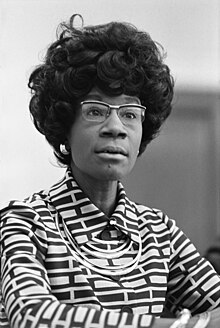
Text je dostupný za podmienok Creative Commons Attribution/Share-Alike License 3.0 Unported; prípadne za ďalších podmienok. Podrobnejšie informácie nájdete na stránke Podmienky použitia.
Antropológia
Aplikované vedy
Bibliometria
Dejiny vedy
Encyklopédie
Filozofia vedy
Forenzné vedy
Humanitné vedy
Knižničná veda
Kryogenika
Kryptológia
Kulturológia
Literárna veda
Medzidisciplinárne oblasti
Metódy kvantitatívnej analýzy
Metavedy
Metodika
Text je dostupný za podmienok Creative
Commons Attribution/Share-Alike License 3.0 Unported; prípadne za ďalších
podmienok.
Podrobnejšie informácie nájdete na stránke Podmienky
použitia.
www.astronomia.sk | www.biologia.sk | www.botanika.sk | www.dejiny.sk | www.economy.sk | www.elektrotechnika.sk | www.estetika.sk | www.farmakologia.sk | www.filozofia.sk | Fyzika | www.futurologia.sk | www.genetika.sk | www.chemia.sk | www.lingvistika.sk | www.politologia.sk | www.psychologia.sk | www.sexuologia.sk | www.sociologia.sk | www.veda.sk I www.zoologia.sk

